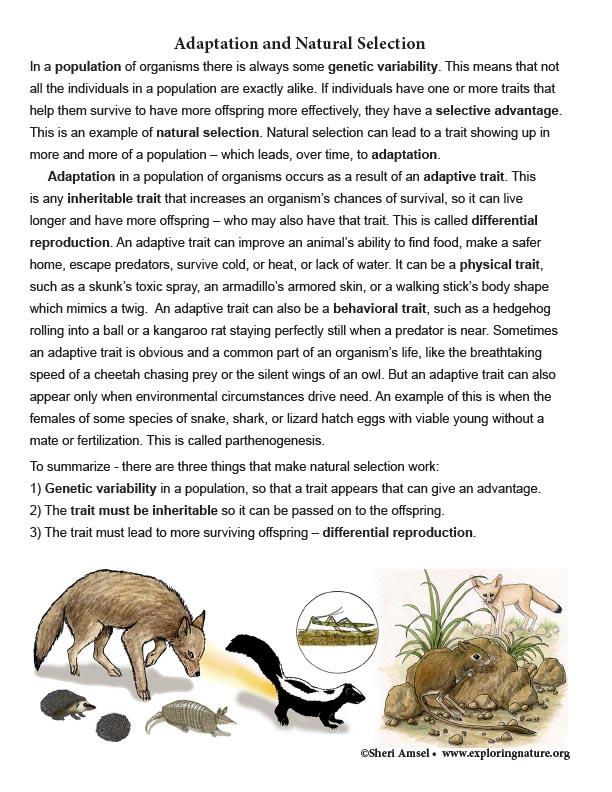

In a population of organisms there is always some genetic variability. This means that not all the individuals in a population are exactly alike. If individuals have one or more traits that help them survive to have more offspring more effectively, they have a selective advantage. This is an example of natural selection. Natural selection can lead to a trait showing up in more and more of a population – which leads, over time, to adaptation.
Adaptation in a population of organisms occurs as a result of an adaptive trait. This is any inheritable trait that increases an organism’s chances of survival, so it can live longer and have more offspring – who may also have that trait. This is called differential reproduction. An adaptive trait can improve an animal’s ability to find food, make a safer home, escape predators, survive cold, or heat, or lack of water. It can be a physical trait, such as a skunk’s toxic spray, an armadillo’s armored skin, or a walking stick’s body shape which mimics a twig. An adaptive trait can also be a behavioral trait, such as a hedgehog rolling into a ball or a kangaroo rat staying perfectly still when a predator is near. Sometimes an adaptive trait is obvious and a common part of an organism’s life, like the breathtaking speed of a cheetah chasing prey or the silent wings of an owl. But an adaptive trait can also appear only when environmental circumstances drive need. An example of this is when the females of some species of snake, shark, or lizard hatch eggs with viable young without a mate or fertilization. This is called parthenogenesis.
To summarize - there are three things that make natural selection work:
1) Genetic variability in a population, so that a trait appears that can give an advantage.
2) The trait must be inheritable so it can be passed on to the offspring.
3) The trait must lead to more surviving offspring – differential reproduction.
Test your comprehension with a Adaptation and Natural Selection - Short Answer Quiz.
When you research information you must cite the reference. Citing for websites is different from citing from books, magazines and periodicals. The style of citing shown here is from the MLA Style Citations (Modern Language Association).
When citing a WEBSITE the general format is as follows.
Author Last Name, First Name(s). "Title: Subtitle of Part of Web Page, if appropriate." Title: Subtitle: Section of Page if appropriate. Sponsoring/Publishing Agency, If Given. Additional significant descriptive information. Date of Electronic Publication or other Date, such as Last Updated. Day Month Year of access < URL >.
Amsel, Sheri. "Adaptation and Natural Selection (6-8 Grade)" Exploring Nature Educational Resource ©2005-2024. December 13, 2024
< http://www.exploringnature.org/db/view/Adaptation-and-Natural-Selection-6-8-Grade >
